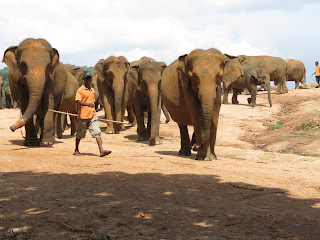Okay, I admit it. At one point during our trip to the orphanage, as we walked around an elephant pie, we wondered aloud how they dealt with all the poo. And then, on our way to the river, we found out ... they make it into paper. Here's how it works.
Of course, this is where it all starts. :)
And this is where it gets transformed. Let's take a look ...
First, the poo is washed and dried. And no, I have no idea how that works and they didn't demonstrate that part, thank goodness. Our guide did say that because elephants eat primarily leaves and tree bark, once the rest of the gunk is washed out, you're left with fibers perfect for paper making as you can see here piled on the table.
This fibrous poo is then mixed with water and maybe some chemicals? and left to ferment for a few days. It looks gross, but didn't really smell at all - we certainly were expecting it to.
It's then dried and colored with dyes to make different colored paper. This particular shop makes a different color each day.
This contraption grinds the fibers and mixes them with water to create a watery oatmeal like consistency. Again, no smell, but it looked disgusting.
Then this paste or whatever you want to call it is put in a tank to sit and settle. The mesh frame you can kind of see in the photo creates the shape of the paper. When the paste has settled enough, they can lift it out of the tank and then they set it out in the sun to dry.
This frame has fully dried and the photo below shows a close up of the raw paper that comes off the frame.
The final step (no photo, sorry) is a press that looks like the old time laundry rollers. It's used to press and smooth out the raw paper. And then it's all made into touristy paper products that contribute to the town's economy.
Pretty cool and who would have thought that you could make use out of elephant poo?
Of course, this is where it all starts. :)
And this is where it gets transformed. Let's take a look ...
First, the poo is washed and dried. And no, I have no idea how that works and they didn't demonstrate that part, thank goodness. Our guide did say that because elephants eat primarily leaves and tree bark, once the rest of the gunk is washed out, you're left with fibers perfect for paper making as you can see here piled on the table.
This fibrous poo is then mixed with water and maybe some chemicals? and left to ferment for a few days. It looks gross, but didn't really smell at all - we certainly were expecting it to.
It's then dried and colored with dyes to make different colored paper. This particular shop makes a different color each day.
This contraption grinds the fibers and mixes them with water to create a watery oatmeal like consistency. Again, no smell, but it looked disgusting.
Then this paste or whatever you want to call it is put in a tank to sit and settle. The mesh frame you can kind of see in the photo creates the shape of the paper. When the paste has settled enough, they can lift it out of the tank and then they set it out in the sun to dry.
This frame has fully dried and the photo below shows a close up of the raw paper that comes off the frame.
The final step (no photo, sorry) is a press that looks like the old time laundry rollers. It's used to press and smooth out the raw paper. And then it's all made into touristy paper products that contribute to the town's economy.
Pretty cool and who would have thought that you could make use out of elephant poo?
































